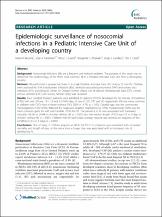Epidemiologic surveillance of nosocomial infections in a Pediatric Intensive Care Unit of a developing country

View/
Download
(application/pdf: 754.9Kb)
(application/pdf: 754.9Kb)
Date
2010-09-10Author(s)
Becerra, María R.
Tantaleán, José A.
Suárez, Víctor J.
Alvarado, Margarita C.
Candela, Jorge L.
Urcia, Flor C.
Metadata
Show full item recordAbstract
Background: Nosocomial Infections (NI) are a frequent and relevant problem. The purpose of this study was to determine the epidemiology of the three most common NI in a Pediatric Intensive Care Unit from a developing country.
Methods: We performed a prospective study in a single Pediatric Intensive Care Unit during 12 months. Children were assessed for 3 NI: bloodstream infections (BSI), ventilator-associated pneumonia (VAP) and urinary tract infections (UTI), according to Center for Disease Control criteria. Use of devices (endotracheal tube [ETT], central venous catheter [CVC] and urinary catheter [UC]) was recorded.
Results: Four hundred fourteen patients were admitted; 81 patients (19.5%) developed 85 NIs. Density of incidence of BSI, VAP and UTI was 18.1, 7.9 and 5.1/1000 days of use of CVC, ETT and UC respectively. BSI was more common in children with CVCs than in those without CVCs (20% vs. 4.7%, p < 0.05). Candida spp. was the commonest microorganism in BSI (41%), followed by Coagulase-negative Staphylococcus (17%). Pseudomonas (52%) was the most common germ for VAP and Candida (71%) for UTI. The presence of NI was associated with increased mortality (38.2% vs. 20.4% in children without NI; p < 0.001) and the median length of ICU stay (23 vs. 6 days in children without NI; p < 0.001). Children with NI had longer average hospital stay previous to diagnosis of this condition (12.3 vs. 6 days; p < 0.001).
Conclusions: One of every 5 children acquires an NI in the PICU. Its presence was associated with increased mortality and length of stay. At the same time a longer stay was associated with an increased risk of developing NI.
Collections
- Artículos [274]







